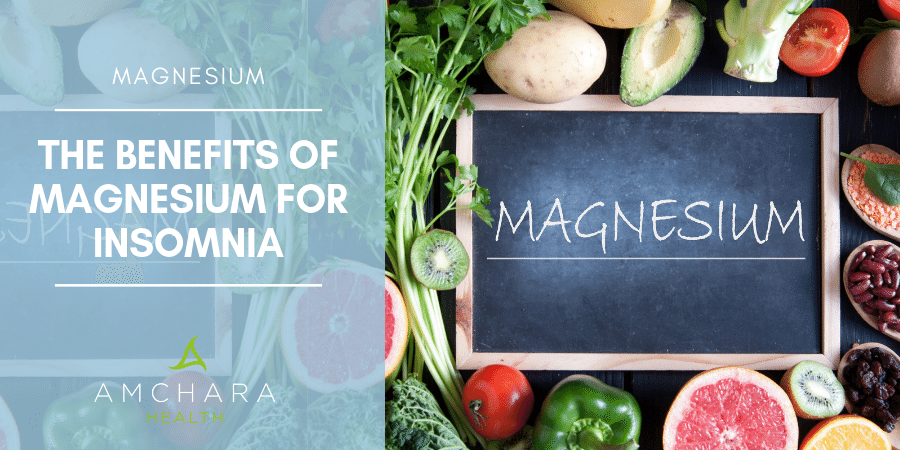The word “magnesium” comes from the name of the Greek region Magnesia, where compounds of this element occur naturally. This mineral is the eighth most abundant element in the Earth’s crust (1), plentiful both in nature and the human body. It works alongside calcium to maintain both bone density and nerve and muscle impulses, but has numerous other equally important functions in the body.
We always take an evidence-based approach and in this article we delve deeper into the role of magnesium in the human body, signs of deficiency, how much you need to function optimally, what the best sources of magnesium are and how it can have a positive impact on your sleep quality.
What is insomnia?
Insomnia is widespread, affecting approximately 36% of the population in the UK (15) and is characterised by difficulty falling asleep, inability to stay asleep, or waking in the early hours and not being able to get back to sleep.
Whilst insomnia is a symptom that can have many causes, psychological problems such as anxiety, depression and stress as well as dietary intake are some of the most common reasons.
Other important factors worth considering include the following:
- Certain drugs, such as thyroid preparations, oral contraceptives and beta blockers may produce side effects including insomnia.
- Withdrawal symptoms when coming off certain drugs may cause insomnia.
- Alcohol, although seemingly effective at promoting deep sleep initially, will actually disrupt your sleep after the first few hours. Alcohol also destroys some of the B-group vitamins, important for normal sleep rhythms.
- Cannabis and other addictive drugs can produce disturbing dreams promoting wakefulness during the night.
- Caffeine, found in tea, coffee, chocolate and cola-based drinks has a stimulating effect which can lead to insomnia.
- Health conditions such as arthritic pain, cystitis and diarrhoea may cause broken sleep.
- Shift work, involving working some nights and not others, is likely to severely disrupt sleep patterns.
There are also specific disorders that interfere with sleep, such as sleep apnoea, where breathing repeatedly stops and starts throughout the night. This is most common in adults but may occasionally occur in children.
Obesity is a primary factor in sleep apnoea, but it can also be due to a physical abnormality of the chest, back, neck or base of the brain.
Restless leg syndrome is another disorder, more common in women and more severe in the elderly, characterised by an irresistible urge to move the legs. Symptoms mostly occur in the late afternoon or evening hours, and are often most severe at night when a person is resting, either sitting or lying in bed.
What do we know about magnesium?
Magnesium makes up 2% of the Earth’s outermost layer, but you cannot see this silvery light metal in nature. This versatile element occurs naturally, but only in combination with other elements, such as carbon, calcium and oxygen. (4)
Magnesium is one of the elements essential to all cellular life. Next to potassium, magnesium is the second most abundant ion found within our cells.
It has been identified as being involved in the activation of more than 300 enzymes and body chemicals and is a key component for energy metabolism. It is also essential for the production of protein and nucleic acid.
Over half the magnesium in the body is deposited in the bone, with the remainder found in the soft tissues. The blood contains less than 1%. (3)
Our intake of magnesium is normally gained through both food and water (2) and is absorbed from the small intestine. It is controlled in the blood serum by excretion from the kidneys.
Magnesium is very chemically active, being involved in numerous structural and functional tasks in the body including the maintenance of healthy bones as well as proper functioning of the muscles and nerves. This important mineral is also essential to sustain the normal rhythm of the heart.
Magnesium is critical for energy production and is therefore often a major factor in fatigue related disorders such as myalgic encephalomyelitis (ME) or chronic fatigue syndrome (CFS).
Because of its vital role in the metabolism of carbohydrates, and the synthesis and secretion of insulin, it is also linked to diabetes – diabetes sufferers are often found to be deficient in magnesium.
Magnesium deficiency signs and symptoms
Magnesium deficiency appears to be extremely common. When testing for nutritional deficiencies, doctors in the U.K. find magnesium deficiency more frequently than any other mineral.
Low levels of magnesium in the diet and in our bodies may increase susceptibility to a variety of diseases, including heart disease, high blood pressure, kidney stones, Alzheimer’s, cancer, insomnia, PMS, strokes and menstrual cramps.
Signs and symptoms of magnesium deficiency are fatigue, mental confusion, irritability, weakness, heart disturbance, problems in nervous conduction and muscle contraction, muscle cramps, loss of appetite, insomnia and predisposition to stress.
Importance of magnesium in disease prevention
Because of magnesium’s many functions within the body, it plays a major role in disease prevention and overall health.
- Alleviating pain
Pain related disorders such as migraine, tension headaches and Fibromyalgia may be improved by magnesium supplementation. With migraine and tension headaches this is likely due to its effects on vascular muscle function and nerve relaxation.
- Heart health
Magnesium works alongside calcium, sodium and potassium to control the muscle tone of blood vessels – because of this it has been studied extensively for its role in cardiovascular disease. (9) The heart is particularly sensitive to depleted magnesium levels and low levels of this mineral are linked to increased risk of sudden cardiac arrest. (10).
Magnesium deficiency is a common feature of conditions such as high blood pressure, congestive heart failure, arrhythmias, peripheral vascular disease and mitral valve prolapse.
Research has shown that supplementing with magnesium has a pronounced positive effect on patients with heart disease, to the extent that it is able to relax coronary arteries by affecting smooth muscle contractibility. (11) It has also been found to reduce the clotting ability of platelets in the blood, lessening the risk of thrombosis (12).
Living in a hard water area may offer additional health benefits as hard water contains higher levels of magnesium salts. Studies have found people living in these areas have a reduced risk of heart disease. (13)
- Keeping the nervous system healthy
Together with calcium, magnesium is needed to maintain optimum nerve impulse transmission. This is due to its influence on neurotransmitters, the chemical messengers of the nervous system.
- Maintaining hormonal balance
Magnesium has a significant effect on female hormones. High levels of magnesium are associated with lower levels of aldosterone, a hormone that causes sodium and fluid retention. This is linked to the weight gain and breast pain common in PMS patients. Research shows that pre-menstrual mood swings are also reduced following supplementation with a combination of magnesium and vitamin B6. (7)
- Managing stress
Magnesium works alongside vitamin C, B6, pantothenic acid and zinc to maintain adrenal health and produce adrenal stress hormones. Dietary imbalances, such as high intakes of fat and or calcium, can intensify magnesium inadequacy, especially under conditions of stress. Stress, whether physical or emotional, increases the need for magnesium. (5)
- Reducing depression
It appears magnesium may be useful in relieving depression. A study by Barragen et al in 2008 found that magnesium chloride given at 450mg daily over 12 weeks was just as effective at reducing depression in diabetic elderly patients as a 50mg daily dose of antidepressant medication (8).
- Supporting the human skeleton
Magnesium helps to regulate calcium within the teeth and bones – in fact magnesium is required for calcium to be bound to teeth enamel.
As well as influencing the hormonal processes involved in the metabolism of bone calcium, magnesium is thought to increase the activity of vitamin D, also involved in calcium absorption. Studies show magnesium is as important for skeletal health as calcium and that women with osteoporosis are found to have less bone magnesium.
Individual requirements for magnesium
Data from around the world shows that magnesium intake is inadequate amongst most populations.
Scientists investigating the food supply of hunter gatherers in Palaeolithic times showed an average dietary intake of 600mg a day of magnesium, much higher than today. The human genome and homeostatic mechanisms remain the same as they were for our Stone Age ancestors, suggesting we are best adapted to a high intake of magnesium (17).
According to The UK’s Department of Health, the Reference Nutrient Intake (RNI) of magnesium for adults should be 300mg per day. However, such reference values simply represent average data and do not take into account factors that may increase an individual’s requirement for magnesium such as poor diet, stress and drug interactions.
Many nutrition experts now feel that the average world RNI should be set at 450mg per day. This view is particularly relevant when reviewing the 1994 MAFF dietary and nutritional survey showing that 72% of women and 42% of men between the ages of 19 and 50, and an incredible 89% of UK females in their late teens (16-18 years), do not achieve the RNI for magnesium (14).
At the beginning of this century, daily intakes of magnesium were in the region of 1200mg. Modern intensive farming methods, together with food processing and refining techniques, have caused considerable amounts of this mineral to be lost from our daily food intake.
Traditional methods of farming involve the use of manure and compost to increase the mineral content of the soil, whereas modern farming methods produce a higher crop yield, but poorer quality food due to the emphasis on using large quantities of inorganic fertilisers. This involves overuse of nitrates, phosphates and potassium salts as fertilisers, draining the soil of magnesium and ultimately depleting it of essential minerals.
When grains are milled to make white flour, approximately 85% of the magnesium is lost. Thus, our modern food supply starts off short in magnesium and after processing the shortage is even greater.
Added to this problem is one of individual food preferences. Dietary intake of magnesium has been shown to be insufficient in Western populations, with many choosing to eat low magnesium foods such as refined cereals, pastry, refined flour pasta, refined white rice, refined sugar, meat, fish and popular fruits. At the same time Western diets are also lacking in typically high-magnesium foods such as nuts, seeds, tofu, oats, whole grains (especially rice and millet) and green leafy vegetables.
Other factors can rob the body of magnesium or interfere with its absorption, such as the use of diuretics, oestrogen, oral contraceptives, alcohol, caffeine and a diet high in calcium and phosphate. Soft drinks contain around 30mg phosphates, which will bind to an equal amount of magnesium, preventing its absorption.
Physical, emotional and chemical stresses are also known to deplete magnesium by causing the release of adrenaline which draws magnesium out of the cells, allowing it to be flushed out in the urine. In fact, animal studies have shown that something as simple as excessive noise can result in magnesium being lost from the body.
Sources of magnesium
Food is always a good place to start for the essential vitamins and minerals that your body needs. The average diet is relatively high in calcium but deficient in magnesium partly because milk, a major source of calcium, contains very little magnesium.
However, both minerals are present in green leafy vegetables, nuts and seeds. Magnesium is an essential constituent of the green pigment chlorophyll, which gives plants and algae their green colour. It is therefore present in all green vegetables, so eating lots of green leafy veggies daily will give you a beneficial magnesium boost.
Magnesium content of foods
| Type of food | Food | Serving size | Milligrams magnesium |
| Nuts and seeds | |||
| Almonds, dried | 2 oz | 168 | |
| Brazil nuts, dried | 2 T | 128 | |
| Cashew nuts, dry roasted | 2 oz | 148 | |
| Coconut, dried | 2 oz | 52 | |
| Flaxseed | 2 T | 70 | |
| Peanuts, dry roasted | 2 oz | 98 | |
| Peanut butter, natural | 2 T | 51 | |
| Pumpkin seeds, dried | 2 oz | 304 | |
| Sesame seeds, whole, dried | 2 oz | 64 | |
| Sunflower seed kernels, dried | 2 oz | 200 | |
| Walnuts, black, dried | 2 oz | 114 | |
| Watermelon seeds, dried | 2 oz | 292 | |
| Leafy greens | |||
| Chard, boiled | 1/2 cup | 76 | |
| Collard greens, boiled | 1/2 cup | 26 | |
| Kale, boiled | 1/2 cup | 12 | |
| Spinach, boiled | 1/2 cup | 79 | |
| Spinach, raw | 1 cup | 44 | |
| Turnip greens, boiled | 1/2 cup | 16 | |
| Seaweed, kelp | 3.5 oz | 121 | |
| Seaweed, spirulina, dried | 3.5 oz | 195 | |
| Grains | |||
| Barley pearl, cooked | 1/2 cup | 17 | |
| Barley whole grain, cooked | 1/2 cup | 61 | |
| Corn, yellow, cooked | 1/2 cup | 26 | |
| Quinoa, cooked | 1/2 cup | 89 | |
| Buckwheat groats, cooked | 1/2 cup | 51 | |
| Millet, whole grain, cooked | 1/2 cup | 53 | |
| Oats, bran | 1/2 cup | 96 | |
| Oats, whole grain, cooked | 1/2 cup | 56 | |
| Oatmeal, quick, regular, or instant, cooked | 1/2 cup | 56 | |
| Rice, long grain brown, cooked | 1/2 cup | 42 | |
| Rice, long grain, white, cooked | 1/2 cup | 13 | |
| Rice, wild, cooked | 1/2 cup | 27 | |
| Rye, whole grain | 1/2 cup | 35 | |
| Wheat, vran | 2 T | 10 | |
| Wheat, bulgur, cooked | 1/2 cup | 29 | |
| Wheat, couscous, cooked | 1/2 cup | 15 | |
| Wheatgerm, raw | 1/4 cup | 69 | |
| Wheatgerm, toasted | 1/4 cup | 91 | |
| Beans | |||
| Adzuki beans, boiled | 1/2 cup | 60 | |
| Black beans, boiled | 1/2 cup | 61 | |
| Cowpeas (Black-eye), boiled | 1/2 cup | 43 | |
| Great northern beans, boiled | 1/2 cup | 44 | |
| Green snap/string beans, boiled | 1/2 cup | 16 | |
| Green peas, boiled | 1/2 cup | 16 | |
| Hummus | 1/2 cup | 36 | |
| Kidney beans, red, boiled | 1/2 cup | 40 | |
| Lentils, boiled | 1/2 cup | 36 | |
| Lima beans, boiled | 1/2 cup | 41 | |
| Navy beans, boiled | 1/2 cup | 54 | |
| Pinto beans, boiled | 1/2 cup | 48 | |
| Soybeans, boiled | 1/2 cup | 74 | |
| Tofu, raw | 1/2 cup | 127 | |
| Tempeh, cooked | 1/2 cup | 58 | |
| Miscellaneous | |||
| Blackstrap molasses | 2 T | 86 | |
| Chocolate, unsweetened | 1 oz | 88 | |
| Fruits and
vegetables |
|||
| Acorn squash, baked | 1/2 cup | 43 | |
| Apple, raw w/skin | 1 medium | 6 | |
| Avocado, california | 1 medium | 70 | |
| Avocado, florida | 1 medium | 104 | |
| Banana | 1 medium | 33 | |
| Beets, boiled | 1/2 cup | 31 | |
| Blueberry | 1.2 cup | 4 | |
| Broccoli, boiled | 1/2 cup | 19 | |
| Cantaloupe | 1/2 cup pieces | 9 | |
| Carrots, raw | 1 Medium | 11 | |
| Cauliflower, boiled | 1/2 cup | 17 | |
| Cucumber, raw | 1/2 cup sliced | 6 | |
| Dates, dried | 5 dates | 15 | |
| Grapes | 1/2 cup variety kinds | 3 | |
| Kiwi | 1 medium | 23 | |
| Mango | 1 medium | 18 | |
| Mushrooms, boiled | 1/2 cup, pieces | 10 | |
| Okra, boiled | 1/2 cup, sliced | 46 | |
| Onions, boiled | 1/2 cup | 11 | |
| Orange, navel | 1 medium | 15 | |
| Peppers, sweet, raw | 1 cup, chopped | 10 | |
| Potato, white, baked w/skin | 1 potato | 55 | |
| Potato, white, baked w/o skin | 1 potato | 39 | |
| Potato, white, boiled w/o skin | 1 potato | 26 | |
| Potato, sweet, boiled w/o skin | 1/2 cup mashed | 16 | |
| Strawberry | 1/2 cup | 8 | |
| Tomato, raw, ripe | 1 | 13 | |
| Tomato, boiled | 1/2 cup | 16 | |
| Watermelon | 1/2 cup | 8 | |
| Zucchini, boiled | 1/2 cup sliced | 19 | |
| Flesh | |||
| Beef, brisket, braised | 3.5 oz | 24 | |
| Beef, ground, lean, broiled, well done | 3.5 oz | 24 | |
| Beef, tenderloin, lean, roasted | 3.5 oz | 30 | |
| Chicken, dark meat, w/o skin, roasted | 3.5 oz | 23 | |
| Chicken, Light Meat, w/o skin | 3.5 oz | 27 | |
| Seafood, halibut, baked/broiled | 3 oz | 78 | |
| Seafood, salmon, sockeye, baked/broiled | 3 oz | 20 | |
| Seafood, shrimp, boiled | 3 oz | 29 | |
| Seafood, tuna, skipjack, baked/broiled | 3 oz | 37 | |
| Ham, roasted | 3.5 oz | 17 | |
| Turkey breast, smoked | 3.5 oz | 22 | |
| Dairy | |||
| Milk, cow, 2% fat | 8 oz | 33 | |
| Milk, non-fat | 8 oz | 28 | |
| Milk, goat | 8 oz | 34 | |
| Milk, soy | 8 oz | 45 |
Sources: Bowes and Church’s Food Values of Portions Commonly Used, Sixteenth Edition; Food Processor for Windows [Nutrition Analysis Software]. Version 7.60. Salem, OR: ESHA Research; 2000 Dec; USDA Nutrient Database.
Magnesium therapy for insomnia
Magnesium deficiency has been linked to higher levels of stress, anxiety and difficulty relaxing – key factors in achieving a good night’s sleep. Magnesium also interacts with an important sleep promoting neurotransmitter and can work in many ways to preserve the health of the nervous system.
During times of stress, magnesium stores may be depleted and large amounts of this important mineral are lost in the urine.
Some of the symptoms of stress, including stimulation of the nervous system, are reduced when blood levels of magnesium are normal to high and are exacerbated in the presence of a magnesium deficiency.
Research has revealed that animals fed a magnesium deficient diet react violently to previously well tolerated noise. Consuming adequate amounts of magnesium prior and during the stressful noise reduces the stress reaction.
A further study investigating restless leg syndrome, showed both an improvement in sleep efficiency and a reduction in the periodic limb movement of the participants, following magnesium supplementation. (16)
With its ability to exert a calming effect on the nervous system together with its muscle relaxing role, magnesium, taken 30-40 minutes before retiring for bed, may help those suffering stress or restless leg syndrome related insomnia. In fact, one of the early uses of magnesium within the medical profession was to induce sleep. This relaxation mineral was often chosen by doctors because it reduces stress and anxiety by lowering cortisol levels in the body.
It is also significant to note that hibernating animals have very high magnesium levels.
Magnesium’s complex involvement in the biological processes which govern a person’s ability to sleep indicates that magnesium may be a worthwhile therapy for many people suffering from insomnia.
Take home message
If you are looking to manage your insomnia, it’s worth exploring whether the cause of your disturbed sleep patterns is due to a magnesium deficiency.
At Amchara, we can provide advanced functional medicine laboratory tests to measure your vitamin and mineral status and so much more, to help you achieve optimal health.
Did you find this article useful?
Have you tried magnesium to help you sleep better?
We’d love to hear from you, get in touch.
READ THIS NEXT:




